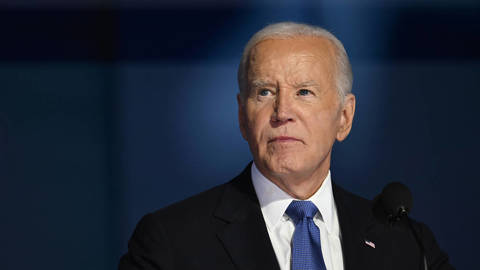-
Will Trump Crack the Mystery of COVID’s Origin?

Will Trump Crack the Mystery of COVID’s Origin?
Brahma Chellaney urges the incoming US administration to tighten rules governing risky “gain-of-function” research. -
Social Media as It Should Be

Social Media as It Should Be
Robin Berjon explains how the Bluesky model could restore the original promise of the internet. -
Trump’s Greenland Grab

Trump’s Greenland Grab
Carl Bildt explains why the US president-elect's threats to seize the Danish territory are so dangerous. -
Joe Biden’s Disappearing Legacy

Joe Biden’s Disappearing Legacy
Richard Haass thinks the outgoing US president got some big things mostly right and some big things mostly wrong. -
AI Alone Won’t Save the Planet

AI Alone Won’t Save the Planet
Yana Gevorgyan calls for an “augmented intelligence” that combines algorithms with human knowledge and lived experience. -
Will US Democracy Survive Trump?

Will US Democracy Survive Trump?
Koichi Hamada considers the tactics that enabled the president-elect to push America toward autocracy. -
Can Trump Dump the Dollar?

Can Trump Dump the Dollar?
Barry Eichengreen argues that while the incoming administration could certainly weaken the greenback, the US would not benefit. -
A No-Brainer for Global Growth and US Jobs

A No-Brainer for Global Growth and US Jobs
Joseph E. Stiglitz & Mark Weisbrot call for a new issuance of the International Monetary Fund’s international reserve asset. -
What Will Trump Do to the US Economy?

What Will Trump Do to the US Economy?
From cutting taxes to raising tariffs to eroding central-bank independence, US President-elect Donald Trump has made a wide range of economic promises, many of which threaten to blow up the deficit and fuel inflation. But powerful institutional, political, and economic constraints, together with Trump’s capriciousness, have spurred disagreement about how worried we should be.

ATHENS/BERLIN – Governments throughout the European Union and around the world confront a seeming Catch-22: the millstone of national debt around their necks has required them to reduce deficits through spending cuts and tax increases. But these are impeding the consumer spending needed to boost economic activity and kick-start growth. As the debate shifts from austerity towards measures aimed at stimulating growth, smarter taxation will be essential to getting the balance right.
When governments think about the difficult task of raising taxes, they usually think about income tax, business taxes, and value-added tax (VAT). But there are other taxes that can raise significant amounts of revenue with a much less negative impact on the economy. These are the taxes that governments already levy on electricity and fossil fuels.
Such taxes play a crucial role in cutting the carbon emissions that cause climate change. But recent research shows that they can also play a useful role in raising government revenue at little cost in terms of economic growth.
Euro for euro, dollar for dollar, yen for yen: energy and carbon taxes have a lower negative impact on a nation’s economy, consumption, and jobs than income tax and VAT. For example, an increase in direct taxes, such as income tax, can reduce consumption by twice as much as energy and carbon taxes that raise the same amount of revenue.
Maintaining consumption at as high a level as possible is vital to reviving economic activity, which means that freeing money for consumers to spend is just as important. Energy and carbon taxes can raise revenue while leaving the economy in a stronger state to sustain a recovery. Conventional taxes raise revenue, but pose a much greater risk of depressing growth in the process.
This is not the only reason why looking more closely at energy and carbon taxes makes sense. The current framework for energy taxation, particularly in Europe, is not sustainable. Tax rates on different fuels vary by more than 50% across the EU, causing major distortions in the single market. Creating a level playing field on energy taxation in the EU would harmonize economic incentives, eliminate gas-tank tourism by drivers crossing borders for lower prices, and improve the business climate in all of Europe’s economies.
Secure your copy of PS Quarterly: The Year Ahead 2025
Our annual flagship magazine, PS Quarterly: The Year Ahead 2025, has arrived. To gain digital access to all of the magazine’s content, and receive your print copy, subscribe to PS Digital Plus now.
Subscribe Now
Rising energy bills, driven by the cost of fossil fuels, are a massive political issue in many countries in Europe and elsewhere, including the United States, where consumer energy prices have become a major issue in the run-up to this year’s presidential election. But, relative to other forms of taxation, energy taxation tends to benefit consumers overall. The gains from avoiding the negative impact of conventional taxes work across the economy, particularly as the least well-off maintain a higher level of disposable household income.
Most energy and carbon taxes are levied by national governments. But in Europe there is another option for raising revenues: the European Union Emission Trading Scheme (ETS). In terms of the effect on GDP and jobs, the cost of increasing revenue from this source would be as much as one-third less than that of raising the same amount via income taxes or VAT.
Given Europe’s fiscal deficits and the economic impact of reducing them, that is a huge potential prize. But, first, the issues depressing the carbon price must be addressed. Taking the massive over-allocation of carbon-emission permits out of the ETS will be vital.
Finance ministers everywhere need to think more imaginatively about their fiscal options. Energy and carbon taxes can produce less economic pain and more gain than conventional taxes can. Europe needs fiscal consolidation, reductions in carbon emissions, and a strategy for economic growth. Greater reliance should be placed on energy taxes and an effective ETS to deliver all three.